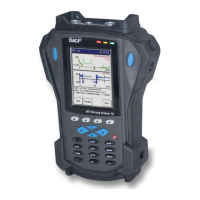Frequency Response Function Module
Recording the Measurement
Windowing – Sets the FFT window type to Uniform or Force/Exponential.
Num of Averages – Sets the number of FFT averages.
Accept/Reject – When carrying out a hammer test, setting Accept/Reject to Manual
displays a dual time trace and presents the user with an accept or reject control. Setting
it to Automatic automatically rejects overloaded data and double impacts.
Invert Phase – Applies a 180
o
phase offset to the measured data. It is used when the
accelerometer or hammer needs to be inverted at a measurement position.
Save To – (Internal or Card) Specify the medium to record to, either the Microlog’s
internal disk or an inserted SD card.
Posn. Autoincr – Works with modal analysis software, if this parameter is set to On,
then an additional Start Index field appears and prompts for the index’s starting
number. For example, if the Start Index is set to 1, then the FRF file is saved as 0001
by default, and then the next file saved is saved as 0002, and so on.
• After setting FRF setup fields, if desired, press the Save function button to name
and save the current settings for future recall.
Recording the Measurement
Once the measurement is set up and the transducers are attached correctly, the next
step is to start collecting data for the FRF.
To Collect FRF Data:
• From the Setup screen, press the Start function button.
If you have Hammer Range, Response Range or Num of Lines set to automatic, a
message displays advising you that you will be asked to perform three trial hits. The
results of these hits are used to automatically determine the best settings for the
associated options.
SKF Microlog - GX Series 8 - 7
User Manual

